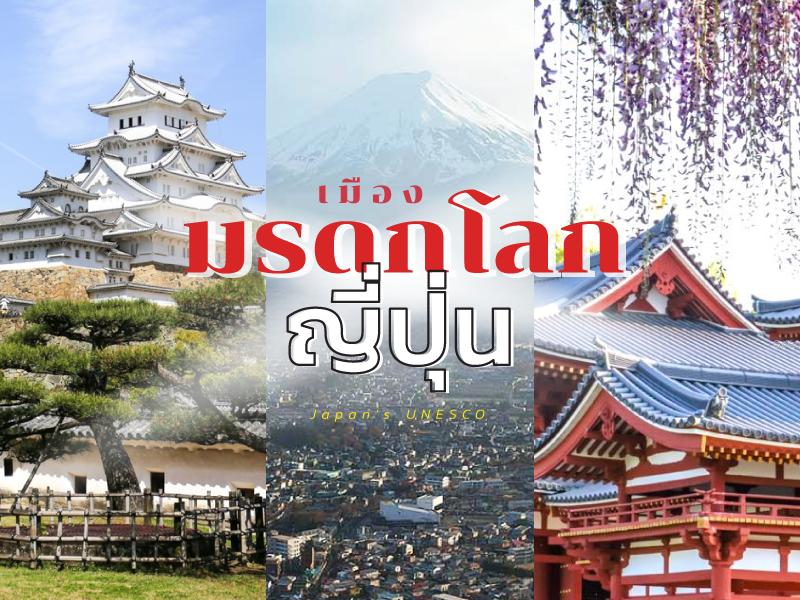
เที่ยวทั่วเมืองมรดกโลกของญี่ปุ่น
 2288
2288
 เที่ยวทั่ว เมืองมรดกโลก ของญี่ปุ่น หลายที่หลายเมือง เปี่ยมไปด้วยธรรมชาติเเละสถาปัตยกรรมมากมาย ไปถึงเเล้วต้องหาโอกาศไปเยือนให้ได้สักครั้ง
เที่ยวทั่ว เมืองมรดกโลก ของญี่ปุ่น หลายที่หลายเมือง เปี่ยมไปด้วยธรรมชาติเเละสถาปัตยกรรมมากมาย ไปถึงเเล้วต้องหาโอกาศไปเยือนให้ได้สักครั้ง
Shirakawa-go is a precious cultural treasure nestled in the mountainous heart of Gifu Prefecture. Set along the narrow Shogawa River basin and surrounded by forested peaks, this historical village features over 200–300-year-old farmhouses arranged in neat rows from north to south, as if time itself stood still.
The village is most renowned for its Gassho-zukuri architecture—named after... read more
The village is most renowned for its Gassho-zukuri architecture—named after... read more
Ainokura village, located deep within a valley, is the most secluded settlement in the Gokayama region of Japan. With nearly 20 gassho-zukuri farmhouses, it is also the largest village in the area. While many of these farmhouses are still occupied by residents, some have been converted into restaurants, museums, and minshuku accommodations.In 1995, Ainokura, alongside Suganuma and Ogimachi, was de...
read more
Mount Fuji, also known as Fujisan, stands as Japan’s tallest volcano at approximately 3,776 meters on Honshu Island. Beyond its natural beauty, it holds deep historical and spiritual significance. It is believed that a monk first climbed Mount Fuji in 1206, and until the Meiji era, the mountain was regarded as sacred, with women prohibited from climbing its summit.
Today, Mount Fuji is recog... read more
Today, Mount Fuji is recog... read more
Himeji Castle, also known as White Heron Castle, is widely regarded as Japan’s most magnificent feudal-era fortress. With its brilliant white walls and elegant, soaring silhouette, it resembles a graceful heron taking flight. As a designated National Treasure and UNESCO World Heritage Site, it holds immense cultural and architectural value—and unlike many other castles, it has never be...
read more
5
Daigoji
มีค่าเข้า ผู้ใหญ่ 600 เยน เด็กอายุ 12-17 ปี 300 เยน เด็กอ... read more
To-ji Temple, founded in 796 AD alongside the establishment of Heian-kyo (present-day Kyoto), was originally built as part of a symmetrical city plan. It stood opposite Sai-ji (West Temple) on either side of the grand Rashomon Gate, marking the southern entrance to the capital. While Sai-ji eventually disappeared, To-ji remains today as the sole surviving symbol of Kyoto’s original imperial ...
read more
Byodoin Temple was originally constructed in 998 as a countryside retreat villa for a powerful political figure of the Heian period. It exemplifies Buddhist Pure Land architecture (Jōdo style), characterized by a carefully designed garden that represents the idealized Pure Land paradise in Buddhist belief. The villa was converted into a temple in 1053 by the son of the original owner, who commissi...
read more
Nikko Toshogu Shrine serves as the magnificent mausoleum of Tokugawa Ieyasu, the founder of the Edo Shogunate. Most of the structures seen today were rebuilt with utmost precision in the 17th century by the third Shogun, Iemitsu. The shrine is renowned for its seamless blend of Shinto and Buddhist elements, reflecting a unique era of religious harmony. The buildings are adorned with gold leaf and ...
read more
The Sannai-Maruyama Site (三内丸山遺跡) in Aomori is one of Japan’s most extraordinary archaeological treasures, dramatically reshaping modern understanding of prehistoric life. Occupied continuously for approximately 1,700 years, from the Early Jōmon to Middle Jōmon periods (circa 3900–2200 BCE), the settlement sprawls across 40 hectares, making it the largest and most complete Jōmon villag...
read more
Shiraito Falls, located in Fujinomiya City, Shizuoka Prefecture, is formed from the melting snow of Mount Fuji. Water streams flow down a 20-meter-high and 200-meter-wide cliff like delicate white silk threads. This waterfall is renowned for its natural beauty and tranquil atmosphere. It is recognized as one of Japan’s top 100 waterfalls and is part of the Mount Fuji area, which was designat...
read more
Todai-ji was founded during the Tempyo era, a time when Japan suffered from repeated natural disasters and widespread epidemics that caused immense human suffering. In 743 CE, Emperor Shomu proclaimed that the people should unite to construct a great Buddha statue, believing that Buddhist devotion could protect the nation and relieve the population from calamities.
According to records preserved a... read more
According to records preserved a... read more
Kasuga Taisha Shrine is one of Japan’s most iconic Shinto shrines and a key component of the UNESCO World Heritage Site "Historic Monuments of Ancient Nara." Founded in 768 AD, it served as the guardian shrine of the ancient capital and the ancestral place of worship for the influential Fujiwara clan.
Renowned for its brilliant vermilion architecture, Kasuga-style sloping roofs, and thousand... read more
Renowned for its brilliant vermilion architecture, Kasuga-style sloping roofs, and thousand... read more
13
Heijo Palace
Oura Cathedral was built in 1865 by French missionary Father Bernard Petitjean and dedicated to the Twenty-Six Martyrs of Japan, who were crucified in Nagasaki in 1597. This Gothic-style church is the oldest surviving Catholic church in Japan. Shortly after its completion, it became famous for revealing the "hidden Christians" (Kakure Kirishitan) from Urakami village, who secretly maintained their...
read more













































